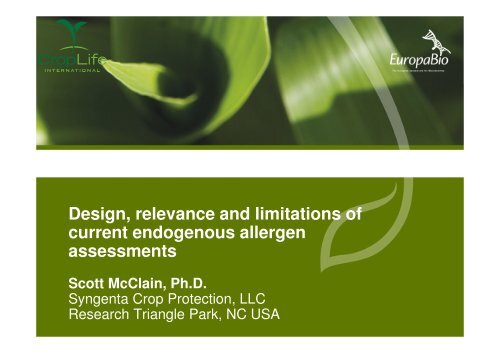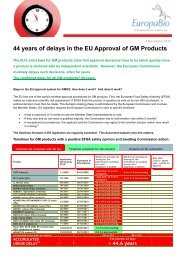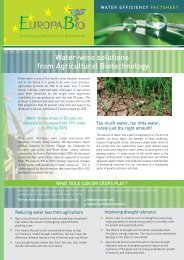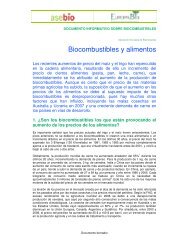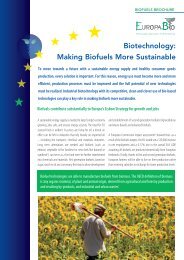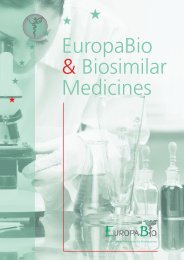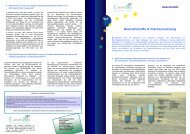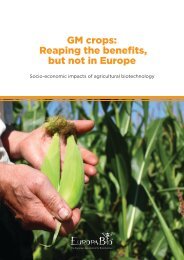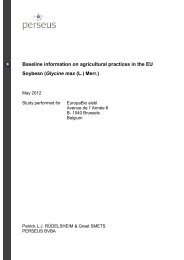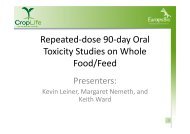Endogenous allergen assessments - Europabio
Endogenous allergen assessments - Europabio
Endogenous allergen assessments - Europabio
You also want an ePaper? Increase the reach of your titles
YUMPU automatically turns print PDFs into web optimized ePapers that Google loves.
Design, relevance and limitations of<br />
current endogenous <strong>allergen</strong><br />
<strong>assessments</strong><br />
Scott McClain, Ph.D.<br />
Syngenta Crop Protection, LLC<br />
Research Triangle Park, NC USA
Design of studies is based, in part, on available<br />
technology<br />
2<br />
-Serologydetection<br />
of <strong>allergen</strong>s<br />
with patient IgE or<br />
animal IgG antibody<br />
-Protein Separation-<br />
Visualize individual<br />
proteins with<br />
stains/serum IgE using<br />
electrophoresis as a<br />
foundation<br />
-Analytical-<br />
Mass spectrometry<br />
is the newest<br />
multiplexing,<br />
quantitative<br />
methodology
IgE, ug/ml<br />
Question: Are <strong>Endogenous</strong> Allergens in Biotech Crops<br />
Increased Relative to Their non-GM Counterparts?<br />
● Has been applied to GM soybean because soybean is considered a<br />
major <strong>allergen</strong>ic food<br />
● Traditionally, the technology available was based on serology:<br />
3<br />
- Use soybean allergic sera as a detection reagent for <strong>allergen</strong>-IgE<br />
binding - measure <strong>allergen</strong> content.<br />
• Total anti-soybean IgE binding ELISA – measures IgE that is specific<br />
to “all” of the <strong>allergen</strong>s a person may be responsive to; quantitatively,<br />
if validated.<br />
• Gel Electrophoresis and Western blotting; can observe binding to<br />
multiple, individual <strong>allergen</strong>s.<br />
Total<br />
IgE<br />
To discriminate individual <strong>allergen</strong>s by ELISA with<br />
serum, individual ELISAs with protein standards<br />
would need to be validated – for soybean this<br />
would minimally be > 8 separate assays*.<br />
Allergen #1<br />
* - University of Nebraska, FARRP <strong>allergen</strong>online.org
Protein Separation and Western Blotting<br />
● Western blotting (WB), and in particular 2-dimensional WB, is of<br />
interest for observing individual proteins<br />
4<br />
- A qualitative observation of the proteins binding serum IgE antibody.<br />
• Although “spots” can be optically measured in general, the<br />
technique is considered semi-quantitative since there are<br />
no standard curves assessed for individual <strong>allergen</strong>s (in<br />
most cases).<br />
- Also perceived as beneficial for observing “new” <strong>allergen</strong>s that<br />
may be present in GM variety…<br />
this is improbable given that new varieties are assessed<br />
prior to market release and exposure. There is also no<br />
premise for new proteins, much less new <strong>allergen</strong>s being<br />
created by introduction of GM trait(s).
2-D Electrophoresis and Western Blotting<br />
Total protein stain shown – Red circle indicates observable soybean proteins by Western<br />
5<br />
Gel Electrophoretic pattern<br />
Taken from Batista et al., 2007. Int Arch Allergy Immunol 2007;144:29–38<br />
IgE reactivity to all of the<br />
possible soybean<br />
<strong>allergen</strong>s is very limited<br />
in a single serum
Considerations for Serology Based Studies<br />
6<br />
Primary Limitation – limited availability of well-characterized sera.<br />
- Variability in IgE binding across one or more proteins among different<br />
patients.<br />
• Not all patients have IgE against a given <strong>allergen</strong> of the same<br />
affinity – thus, quantitative determinations are limited.<br />
- Soybean has many <strong>allergen</strong>s, so thoroughly characterizing the exact<br />
same set of proteins with good reproducibility from one study to the<br />
next is not possible since sera will vary temporally among patients.<br />
- Virtually impossible to have same set of patient sera form one study to<br />
next
Liquid Chromatography MS/MS for Protein<br />
Identification<br />
7<br />
1. Proteins are digested into peptides<br />
2. Peptides are separated to reduce complexity<br />
3. Peptides are “weighed” and sequenced by mass spectrometry<br />
4. Peptide sequence provides protein identification through bioinformatics<br />
S.E. Stevenson, Houston N., and Thelen J. 2010. Regul. Toxicol. Pharmacol.<br />
58, 3, S36-41.
AQUA® Peptide Analysis by MS to Quantify Proteins<br />
Two different<br />
isotopes to label<br />
amino acids<br />
These labeled<br />
(heavier) peptides<br />
can then act as<br />
peptide<br />
Standards<br />
Isotope labeled<br />
Native peptide<br />
AQUA peptide<br />
8<br />
H 2N<br />
H 2N<br />
HO<br />
C<br />
NH<br />
CH 2<br />
CH 2<br />
CH 2<br />
CH<br />
C O<br />
NH<br />
Arginine (R) – 174.2<br />
13 C6H 14 15 N4O 2 – 184.2<br />
1 2<br />
H 2N<br />
HO<br />
NH 2<br />
CH 2<br />
CH 2<br />
CH 2<br />
CH 2<br />
CH<br />
C O<br />
Lysine (K) – 146.19<br />
13 C6H 14 15 N2O 2 – 154.19<br />
LSAEFGSLR – 978.51 VSDDEFNNYK – 1229.52<br />
LSAEFGSLR – 988.51 VSDDEFNNYK – 1237.52
Aqua® Peptides and Quantifying; How does it work?<br />
9<br />
Seed <strong>allergen</strong> peptide (previously identified)<br />
signal<br />
Mix label<br />
with seed<br />
prep<br />
mass<br />
Labeled peptide standard<br />
+<br />
mass spectrometry can distinguish them<br />
+<br />
+<br />
Known amount of<br />
standard added<br />
Ratio gives quantity
Relevance of the Study Design for <strong>Endogenous</strong><br />
Allergen Content<br />
● Premise:<br />
10<br />
- <strong>Endogenous</strong> <strong>allergen</strong>s could, by some unknown mechanism, be<br />
influenced to express at a higher level in GM-traited soybean crops<br />
compared with non-GM<br />
- Soybean – although soybean has many <strong>allergen</strong>s, including<br />
abundant seed storage proteins, the threshold exposure to individual<br />
<strong>allergen</strong>s is not known.<br />
• Therefore, at this point in time, there is no knowledge of how<br />
many µg or mg of an <strong>allergen</strong> is significant from an allergy safety<br />
perspective –<br />
• this in turn limits the study design - a single comparison of GM<br />
versus non-GM control is not useful<br />
- The only relevant study that can be designed is to survey several<br />
non-GM references so there is context to the study in terms of the<br />
natural range of expression for one or more <strong>allergen</strong>s.
µg <strong>allergen</strong> protein/mg total protein<br />
Example – Observing Allergens in the Context of<br />
a Population of Non-GM Varieties (References)<br />
11<br />
120<br />
100<br />
80<br />
60<br />
40<br />
The difference is small<br />
relative to the variability<br />
in the references<br />
GlyG1<br />
GlyG2<br />
Allergen<br />
Test<br />
Control<br />
upper TI<br />
lower TI<br />
Many references can be used to<br />
show the probable range of<br />
expression for a population<br />
The differences between the GM<br />
“test” and its non-GM” control can<br />
then be assessed against the natural<br />
variability in <strong>allergen</strong> expression<br />
Conclusion – in this case, both<br />
<strong>allergen</strong>s show small differences for<br />
the GM variety that are not<br />
biologically relevant
Allergen Context: Understanding Natural Variability<br />
12<br />
Many non-GM reference samples help establish<br />
the concentration range for a new protein (i.e.,<br />
<strong>allergen</strong>) that has clinical implications; particularly<br />
when employing quantitative approaches<br />
Why is this important ?<br />
ug of <strong>allergen</strong> per mg protein<br />
If a protein is being characterized<br />
for the first time, it is critical to<br />
validate the population for its<br />
“normal” content<br />
In the future – the quantity of an<br />
<strong>allergen</strong> could potentially be<br />
correlated to threshold exposure<br />
levels to understand allergy<br />
impact
Soybeans<br />
13<br />
Glycine max<br />
Yes, it’s an<br />
<strong>allergen</strong>ic food<br />
But,<br />
We don’t know how much or<br />
how little causes allergy for<br />
any one of the many protein<br />
<strong>allergen</strong>s<br />
And,<br />
We don’t have evidence that<br />
GM varieties would be<br />
expected to differ in their<br />
<strong>allergen</strong> content<br />
For now,<br />
We can assess GM and<br />
non-GM, but not in<br />
isolation<br />
Small differences are<br />
unlikely to be relevant to<br />
allergy risk – Therefore,<br />
we need to understand<br />
small differences as best<br />
as we can<br />
We cannot predict endogenous<br />
allergy risk relative to a<br />
measured amount of protein…<br />
So, any assessment has to<br />
include a population of<br />
references to understand the<br />
natural variability for any single<br />
<strong>allergen</strong>
<strong>Endogenous</strong> Allergen Approaches<br />
● Question: Are <strong>Endogenous</strong> Allergens in Biotech Crops<br />
Increased Relative to Their non-GM Counterparts?<br />
● Question implies that the target protein(s) can be quantitatively<br />
measured with relevance to allergy risk<br />
14<br />
- ILSI/HESI protein <strong>allergen</strong>icity tech committee has<br />
supported work to use quantitative approaches to provide<br />
measures of soybean <strong>allergen</strong>s<br />
● Methods may include qualitative or quantitative<br />
approaches<br />
● Methods should be:<br />
• Sensitive<br />
• Specific<br />
• Reproducible
Relevance of the data – Can this data be<br />
interpreted for allergy risk?<br />
● Can we measure <strong>allergen</strong>s?<br />
15<br />
- Yes, ability is increasing all the time and with increasing sensitivity<br />
● What is the relevance to the population in terms of their risk for allergy?<br />
- Most <strong>allergen</strong>s still require further study to characterize their<br />
sensitization potential and the amount that causes clinical allergy<br />
- There is no existing hypothesis for a change to endogenous allergy<br />
risk based on GM varieties<br />
● So, even though we have the ability to measure <strong>allergen</strong> content the<br />
question remains – have we added value to the <strong>allergen</strong>icity<br />
assessment?
Contributing EuropaBio Member Companies<br />
● Bayer CropScience<br />
● BASF<br />
● Dow AgroSciences<br />
● Dupont Pioneer<br />
● Monsanto<br />
● Syngenta<br />
16
Questions and Discussion<br />
● Thank your for your attention<br />
17


